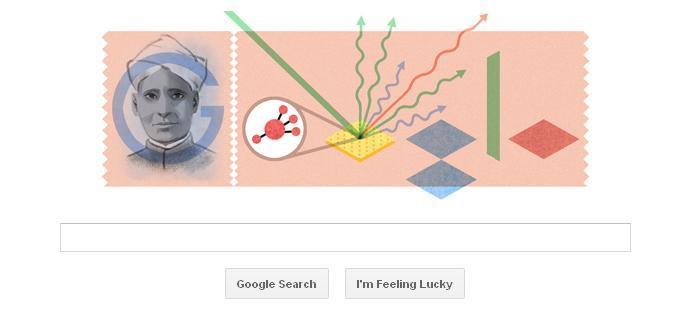Google has bestowed upon its honor on Indian Physicist Sir CV Raman by dedicating to him a doodle on the eve of his 125th birth anniversary. The doodle showing up at the Google India homepage has been styled as a postage stamp and has the physicist’s face appearing behind the letter, and next to it are the other letters of Google logo demonstrating the award-winning Raman Effect discovery.
 CV Raman was born in Thiruvanaikaval (now Tiruchirappalli in Tamilnadu) to Chandrasekhara Iyer and Parvati Ammal on 7th November, 1888. He acquired education from St Aloysius Anglo-Indian High School and then went to Presidency College in Madras at the age of thirteen in 1902. He graduated first place in 1904 with a gold in Physics, and claimed his MA degree with the highest distinction in 1907. In 1917, he joined University of Calcutta as a Physics professor and carried out research at the IACS (Indian Association for the Cultivation of Science), and it was on the fortunate day of 28th February 1928 when an experiment on the scattering of light led to the discovery of Raman Effect.
CV Raman was born in Thiruvanaikaval (now Tiruchirappalli in Tamilnadu) to Chandrasekhara Iyer and Parvati Ammal on 7th November, 1888. He acquired education from St Aloysius Anglo-Indian High School and then went to Presidency College in Madras at the age of thirteen in 1902. He graduated first place in 1904 with a gold in Physics, and claimed his MA degree with the highest distinction in 1907. In 1917, he joined University of Calcutta as a Physics professor and carried out research at the IACS (Indian Association for the Cultivation of Science), and it was on the fortunate day of 28th February 1928 when an experiment on the scattering of light led to the discovery of Raman Effect.
His discovery explained that when light traverses through a dust-free transparent material, come of the scattered light experience altered wavelengths. He was conferred upon with a knighthood in 1929, and he picked up his Nobel Prize for Physics in 1930.
Later he joined Indian Institute of Science, Bangalore, in 1933 and retired in 1944. In 1945, he established Raman Research Institute in Bangalore. He passed away in 1970, at the age of 82.
Google has bestowed upon its honor on Indian Physicist Sir CV Raman by dedicating to him a doodle on the eve of his 125th birth anniversary. The doodle showing up at the Google India homepage has been styled as a postage stamp and has the physicist’s face appearing behind the letter, and next to it are the other letters of Google logo demonstrating the award-winning Raman Effect discovery.
His discovery explained that when light traverses through a dust-free transparent material, come of the scattered light experience altered wavelengths. He was conferred upon with a knighthood in 1929, and he picked up his Nobel Prize for Physics in 1930.
Later he joined Indian Institute of Science, Bangalore, in 1933 and retired in 1944. In 1945, he established Raman Research Institute in Bangalore. He passed away in 1970, at the age of 82.